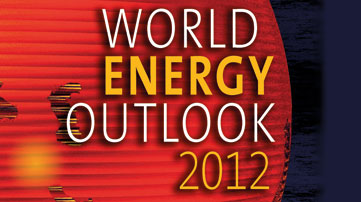12 November 2012
 The global energy map is changing in dramatic fashion, the International Energy Agency said as it launched the 2012 edition of the World Energy Outlook (WEO). The agency's flagship publication, released today in London, said these changes will recast expectations about the role of different countries, regions and fuels in the global energy system over the coming decades.
The global energy map is changing in dramatic fashion, the International Energy Agency said as it launched the 2012 edition of the World Energy Outlook (WEO). The agency's flagship publication, released today in London, said these changes will recast expectations about the role of different countries, regions and fuels in the global energy system over the coming decades.
“North America is at the forefront of a sweeping transformation in oil and gas production that will affect all regions of the world, yet the potential exists for a similarly transformative shift in global energy efficiency,” said IEA Executive Director Maria van der Hoeven. “This year’s World Energy Outlook shows that by 2035, we can achieve energy savings equivalent to nearly a fifth of global demand in 2010. In other words, energy efficiency is just as important as unconstrained energy supply, and increased action on efficiency can serve as a unifying energy policy that brings multiple benefits.”
The WEO finds that the extraordinary growth in oil and natural gas output in the United States will mean a sea-change in global energy flows. In the New Policies Scenario, the WEO’s central scenario, the United States becomes a net exporter of natural gas by 2020 and is almost self-sufficient in energy, in net terms, by 2035. North America emerges as a net oil exporter, accelerating the switch in direction of international oil trade, with almost 90% of Middle Eastern oil exports being drawn to Asia by 2035. Links between regional gas markets will strengthen as liquefied natural gas trade becomes more flexible and contract terms evolve. While regional dynamics change, global energy demand will push ever higher, growing by more than one-third to 2035. China, India and the Middle East account for 60% of the growth; demand barely rises in Organisation for Economic Co-operation and Development (OECD) countries, but there is a pronounced shift towards gas and renewables.
Fossil fuels will remain dominant in the global energy mix, supported by subsidies that, in 2011, jumped by almost 30% to $523 billion, due mainly to increases in the Middle East and North Africa. Global oil demand grows by 7 mb/d to 2020 and exceeds 99 mb/d in 2035, by which time oil prices reach $125/barrel in real terms (over $215/barrel in nominal terms). A surge in unconventional and deepwater oil boosts non-OPEC supply over the current decade, but the world relies increasingly on OPEC after 2020. Iraq accounts for 45% of the growth in global oil production to 2035 and becomes the second-largest global oil exporter, overtaking Russia.
While the regional picture for natural gas varies, the global outlook over the coming decades looks to be bright, as demand increases by 50% to 5 trillion cubic metres in 2035. Nearly half of the increase in production to 2035 is from unconventional gas, with most of this coming from the United States, Australia and China. Whether demand for coal carries on rising strongly or changes course radically will depend on the strength of policy decisions around lower-emissions energy sources and changes in the price of coal relative to natural gas. In the New Policies Scenario, global coal demand increases by 21% and is heavily focused in China and India.
Renewables become the world’s second-largest source of power generation by 2015 and close in on coal as the primary source by 2035. However, this rapid increase hinges critically on continued subsidies. In 2011, these subsidies (including for biofuels) amounted to $88 billion, but over the period to 2035 need to amount to $4.8 trillion; over half of this has already been committed to existing projects or is needed to meet 2020 targets. Ambitions for nuclear energy have been scaled back as countries have reviewed policies following the accident at Fukushima Daiichi, but capacity is still projected to rise, led by China, Korea, India and Russia.
Water is essential to the production of energy, and the energy sector already accounts for 15% of the world’s total water use. Its needs are set to grow, making water an increasingly important criterion for assessing the viability of energy projects. In some regions, water constraints are already affecting the reliability of existing operations and they will introduce additional costs. Expanding power generation and biofuels output underpin an 85% increase in the amount consumed (the volume of water that is not returned to its source after use) through to 2035.
“IEA analysis shows that in the absence of a concerted policy push, two-thirds of the economically viable potential to improve energy efficiency will remain unrealised through to 2035. Action to improve energy efficiency could delay the complete ‘lock-in’ of the allowable emissions of carbon dioxide under a 2oC trajectory – which is currently set to happen in 2017 – until 2022, buying time to secure a much-needed global climate agreement. It would also bring substantial energy security and economic benefits, including cutting fuel bills by 20% on average," said Fatih Birol, IEA Chief Economist and the WEO’s lead author.
WEO-2012 presents the results of an Efficient World Scenario, which shows what energy efficiency improvements can be achieved simply by adopting measures that are justified in economic terms. Greater efforts on energy efficiency would cut the growth in global energy demand by half. Global oil demand would peak before 2020 and be almost 13 mb/d lower by 2035, a reduction equal to the current production of Russia and Norway combined. The accrued resources would facilitate a gradual reorientation of the global economy, boosting cumulative economic output to 2035 by $18 trillion, with the biggest gains in India, China, the United States and Europe.
